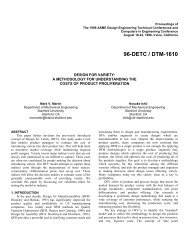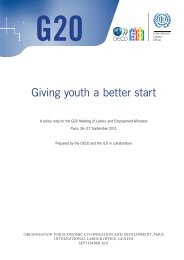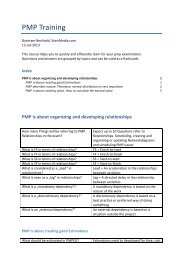Social Marketing
You also want an ePaper? Increase the reach of your titles
YUMPU automatically turns print PDFs into web optimized ePapers that Google loves.
<strong>Marketing</strong> Mix 45<br />
Product<br />
Commercial products are often classified by five variables (Leo Aspinwall, 1958): 3<br />
1. Replacement rate: How frequently is the product repurchased?<br />
2. Gross margin: How much profit is obtained from each product?<br />
3. Buyer goal adjustment: How flexible are buyer’s purchasing habits?<br />
4. Duration of product satisfaction: How long will the product produce benefits?<br />
5. Duration of buyer search behavior: How long will consumers shop for the product?<br />
A similar set of product classes is useful in social marketing.<br />
1. How much product do we need? (How many times do we have to re-supply the product –<br />
ORS is needed for every bout of diarrhea. The fruit pickers; goggles last a long time.)<br />
2. How effective is the product in solving the problem? (How much change does the product<br />
motivate? Re-packaging ORS made a huge difference in compliance; pdas were less dramatic<br />
in their effect on the reef)<br />
3. How competitive is the market place?<br />
4. How many other choices do consumers have? ORS competed against a wide variety of other<br />
popular remedies while there were no good substitutes for the quality of the goggles.<br />
5. How long does the benefit last? The goggles’ benefit was durable. The benefit of colored<br />
condoms was fleeting.<br />
6. How motivated are consumers to find any solution to the problem? Condoms were not what<br />
gay men were looking for. Goggles – if they worked right – were a great solution from the<br />
pickers’ point of view.<br />
Determining the answers to these questions can help social marketers design better, more<br />
effective products. But above all, for social marketers, the product adds benefits to difficult<br />
behaviors that have no immediate reward. When we gave fishermen pdas for the first time, they<br />
loved the technology itself, more than the idea of saving reefs. The product itself became the<br />
benefit of the behavior.<br />
Consumer Demand Design Principles<br />
Product development might be considered the most important and unique contribution that social<br />
marketing brings to social change. While public health scientists, traffic engineers and policy<br />
makers design new social products and services all of the time, too often designers are driven<br />
exclusively by the question: “What works?” Too often these experts ignore the questions: “What<br />
do people want?” “What other choices do they have?” and “What matters most to them?” It is<br />
the purpose of the Product P to answer these questions, and assist the scientist and engineer<br />
in the creation of products and services that are both effective and satisfy consumer wants.<br />
3 Leo Aspinwall, The Characteristics of Goods and Parallel Systems Theories, Managerial <strong>Marketing</strong>, Holmwood IL, Richard<br />
D. Irwin, 1958. pp. 434-50.<br />
<strong>Social</strong> <strong>Marketing</strong> Behavior A Practical Resource for <strong>Social</strong> Change Professionals

















